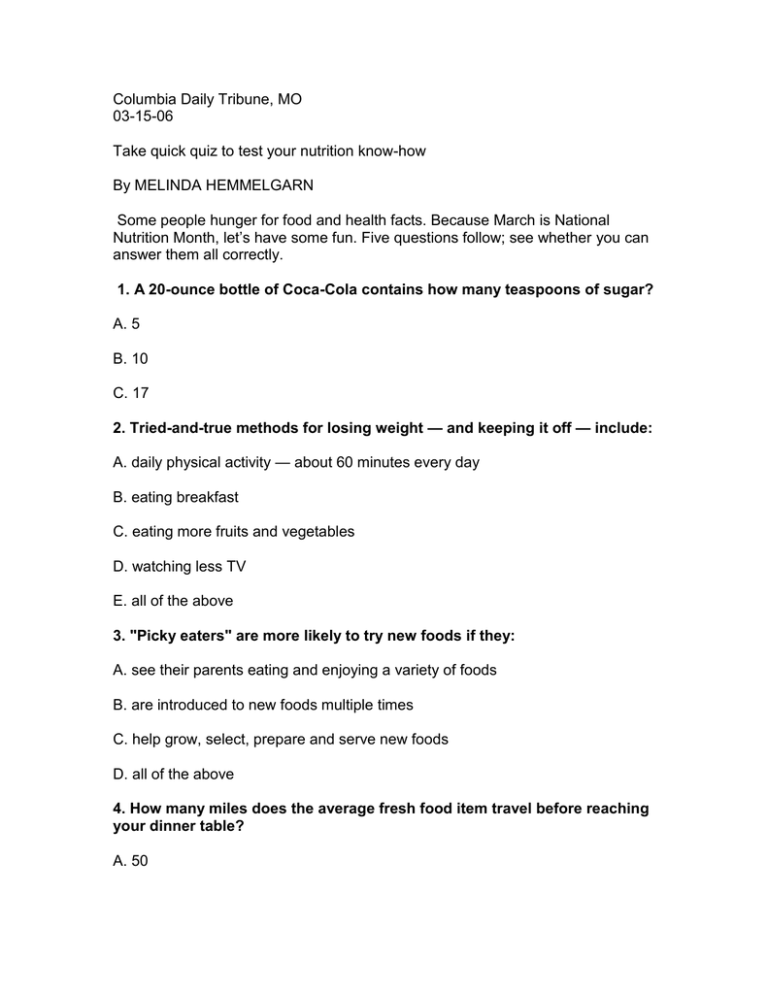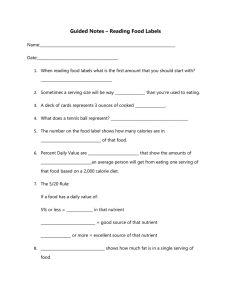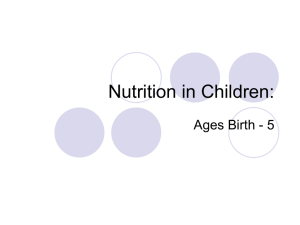Columbia Daily Tribune, MO 03-15-06
advertisement

Columbia Daily Tribune, MO 03-15-06 Take quick quiz to test your nutrition know-how By MELINDA HEMMELGARN Some people hunger for food and health facts. Because March is National Nutrition Month, let’s have some fun. Five questions follow; see whether you can answer them all correctly. 1. A 20-ounce bottle of Coca-Cola contains how many teaspoons of sugar? A. 5 B. 10 C. 17 2. Tried-and-true methods for losing weight — and keeping it off — include: A. daily physical activity — about 60 minutes every day B. eating breakfast C. eating more fruits and vegetables D. watching less TV E. all of the above 3. "Picky eaters" are more likely to try new foods if they: A. see their parents eating and enjoying a variety of foods B. are introduced to new foods multiple times C. help grow, select, prepare and serve new foods D. all of the above 4. How many miles does the average fresh food item travel before reaching your dinner table? A. 50 B. 100 C. 1,500 5. Last month, McDonald’s announced that its french fries contain: A. wheat and dairy ingredients B. beef fat C. sugar Answers: 1) C. Here’s how to do the math: Look on the nutrition facts panel, and find "sugars" listed under "total carbohydrate." Read across to find grams of sugar per serving. At the top of the nutrition facts panel, you’ll find "serving size" and "servings per container." One 20-ounce bottle of Coke contains 2.5 servings, with 27 grams of sugar per 8-ounce serving. If you drink all 20 ounces, you’ll need to do some multiplication: 27 grams of sugar multiplied by 2.5 servings equals 67.5 grams of sugar. There are 4 grams of sugar per teaspoon. So 67.5 divided by 4 equals 17 teaspoons of sugar. To visualize the quantity, measure out 17 teaspoons of sugar into a plastic sandwich bag. Let your children help you; they’ll be amazed. Better choices for your family include water, fat-free or reduced-fat milk and 100 percent fruit juice. The sugar content of fruit juice might seem high, but remember: Unlike fruit drinks and soda, 100 percent juice provides healthpromoting vitamins and minerals and health-protecting anti-oxidants. 2) E. Physical activity burns calories and revs up the metabolic rate. Breakfast skippers set themselves up for eating more food later; plus, they miss out on critical nutrients. Fruits and vegetables help us feel fuller on fewer calories thanks to their water and fiber contents. For children and adults alike, the more TV we watch, the fatter we are. TV-watching is sedentary in nature, and savvy commercials influence our food choices. Most advertised foods fail to meet dietary recommendations. 3) D. Modeling what we teach is our most successful strategy for influencing children’s behavior. Kids also need multiple exposures to new foods before they accept them. However, forcing or bribing children to eat new foods often backfires. It’s better to invite children into the kitchen to help prepare new foods, select new items together at the grocery store and help them plant their own vegetables in a small garden or in pots on a sunny patio. When children participate in growing, cooking and serving new foods, they feel proud. Gardening is an especially powerful way to "cultivate" healthy eating habits. 4) C. Iowa State University’s Leopold Center for Sustainable Agriculture says the average fresh food item travels about 1,500 miles from production to final purchase. A growing number of Americans recognize that smart agriculture is local because it affords communities a greater degree of independence, security and self-sufficiency. 5) A. Both wheat and dairy ingredients can cause allergic reactions in those who are sensitive. However, three years ago, the company acknowledged that its fries were cooked in beef-flavored oil, which resulted in a multimillion-dollar lawsuit. The American Dietetic Association sponsors National Nutrition Month and offers consumers a wide variety of nutrition tips on its Web site. Learn more at www.eatright.org.





